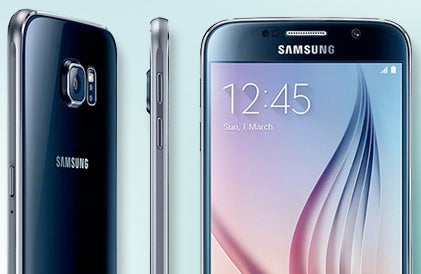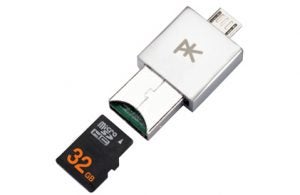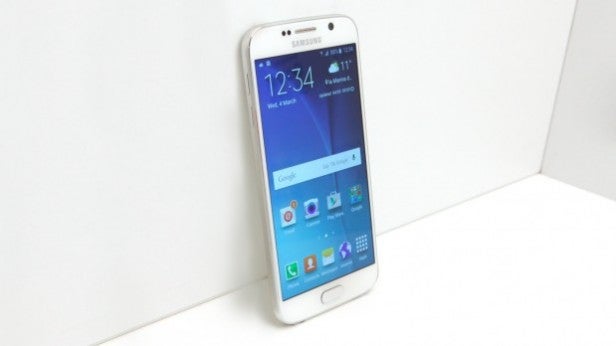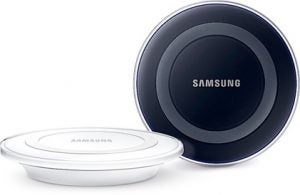Samsung Galaxy S6 problems and how to fix them

Galaxy S6: bug central?
The Samsung Galaxy S6 is one of the best phones ever,
according to quite a lot of people, not just us. However, like just
about every new gadget it’s not without problems.
If you’re thinking about getting hold of one, or already have and are
wondering what you need to look out for, here are the main problems
with the Galaxy S6 and Galaxy S6 Edge.
Some we’ve seen ourselves, others have been reported online. And
we’ll be looking at genuine hardware/software issues as well as some
simple pointers that potential buyers might want to consider. Here are our
Galaxy S6 problems, and how you can fix them…
SEE ALSO: Samsung Galaxy S6 vs Galaxy S6 Edge
Battery life is inconsistent
The Galaxy S6 is a bit of a technical marvel in several respects, but
in an effort to get the phone as thin as possible, it doesn’t have a
big battery. It’s actually smaller and less capacious than the unit in
the Galaxy S5.
Samsung thought it could get away with this downgrade because the
Exynos 7420 processor it uses is unusually efficient thanks to a 14nm
architecture. Without wanting to get too deep into the tech nerdery, the
smaller transistors a system uses, the easier efficiency is to achieve,
and previous generations have 20nm or larger chipsets.
However, in reality its stamina cycles between good, acceptable and
disappointing depending on what you’re doing. With general use it’s not
all that hard to drain the Galaxy S6 down in a day, especially if you’re
doing anything remotely taxing.
How to solve it: Try using the Battery Saver mode, found
in the Settings menu. It throttles the CPU power, keeps a close eye on
screen brightness, turns off vibrate notifications and switches off the
soft key lights.
The compromise is a fairly minor one, and with it you should find it much easier to get a day and a half out of the Galaxy S6.
There are three obvious alternatives. Number one, check out a battery
case. There aren’t many available for the Galaxy S6 yet, but Mophie has
announced one you’ll want to keep an eye out for.
Alternatively, stash an external battery in your bag for emergencies.
Look for one with a 2.1A output and capacity of at least 10,000mAh if
you want to get a few recharges before needing to juice up the pack. However, any
external battery with a USB port will do.
The last fix is to get hold of a wireless charging dock to plonk on
your desk. The Galaxy S6 supports the Qi and PMA standards, covering most wireless charging docks. Of course,
that’s not much good if you don’t work in an office.

There’s no microSD card slot
The design decision that has a lot of people upset with Samsung is
that the Galaxy S6 doesn’t have a microSD card slot. Every other Samsung
Galaxy S flagship to date has had one, and until fairly recently
Samsung seemed to wear it as a badge of nerd-friendly pride.
No longer.
To get more internal storage than the baseline 32GB you’ll need to
upgrade to the 64GB or 128GB versions. Doing so isn’t cheap. The 128GB
Galaxy S6 will cost you up to £840 SIM-free at present.
No matter what Samsung tells us, that upsell is the whole point of cutting out the microSD.
How to solve it: There’s no easy way to hack a microSD slot into the
Galaxy S6. This is a phone, not a desktop PC: the components are already
crammed in like commuters on a rush-hour train.
There are some ways to alleviate storage woe, though. First, think
about getting a memory card USB OTG adapter. What these do is to plug
into the microUSB port on the bottom of the phone and let you access a
memory card as you would when jamming one into a computer, except
through Android.
Of course, this won’t do for day-to-day use, as no-one wants a great big USB dongle sticking out of their phone (see the image below for a size guide).
For more, well, ordinary people the best thing is to just start
pruning what you keep on your phone every now and then. How about
setting up a Galaxy S6 photos folder on your computer that you use
to dump your phone snaps into every now and then, to avoid having to keep
them on your phone’s memory?
If that sounds a bit too much like positive action, why not channel
your anger into a hobby and complain about Samsung on social media
incessantly?

Some buyers report screen issues
We have a feeling this may turn into a red herring of a problem,
but some people have reported their Galaxy S6 Edge phones have
shipped with some strange display issues.
It’s not yellow casts or light bleed, but that the surface of the
screen has lots of very fine nicks on it, as if it has done a stint in
someone’s pocket with a particularly nasty set of keys. We didn’t notice
anything of the sort in our review samples, and as it’s hard to verify the substance of these claims, we’d advise
not obsessing over this one too much.
How to solve it: This is an issue to simply keep an eye
on. It seems more than possible that this is not an wider production issue at
all, but a singular, or at least localised, issue with just a few
units.
After all, Samsung and Corning, who teamed up to make the Galaxy S6
Edge’s display curves, are not new to this sort of design. They pulled
off a similar trick last year with the Note Edge.

It’s not waterproof
One other casualty of the new design style of the Galaxy S6 and
S6 Edge is waterproofing. The Galaxy S5 had it, and for a while it
looked as though it’d become a cornerstone of Samsung phone design.
It was just a passing fad, it seems. This is a minor shame, as we
have seen both headphone jacks and USB ports that offer waterproofing
without needing the sort of rubber seals that make water-resistant
phones a bit of a pain to actually use.
How to solve it: Stress tests of the Galaxy S6 Edge
hardware show that while it’s not waterproof at all, it does survive a
good long while before actually dying aftet being submerged in water – 24
minutes to be exact. A more recent test by SquareTrade saw the regular S6 survive just fine after being submerged for 10 minutes.
Now we’ve not tried this ourselves. However, it’s a good sign about the
phones’ ability to take the odd splash without costing you another £500.
If the worst does happen, you can always try putting the phone in a
bag of uncooked rice for a few days. As much as this sounds like
nonsense, it helps to absorb any water residue from the phone’s insides.
Of course, that won’t help fix any salt/other deposits left should you
have dropped the Galaxy S6 in anything but pure water.
Another option is to get a waterproof case. But these continue to be
pretty bulky things, and therefore are not a satisfying solution for most.
SEE ALSO: Samsung Galaxy S6 vs Galaxy S5
Camera flash bug
One early bug Samsung has acknolwedged relates to the camera
flash. Some have experienced the thing staying on, either at full power
or dimmed, even when the camera isn’t in use.
We haven’t had any problems with this in our time with either the
Galaxy S6 or S6 Edge, but that Samsung has ‘fessed up about its existence it means it’s
definitely a real thing.
How to solve it: Samsung is working on a software fix to
get rid of this bug, so it’s not going to be a problem that’ll loom over
you for too long.
However, if it has struck you may want to consider performing a
factory reset in order to get rid of it right now. You’ll find it in the
Backup and Reset part of the Settings menu. Then, y’know, avoid using
the flash until the fix arrives and, fingers crossed, you’ll be fine.
We’ve heard a flash adds eight years to your face in photos anyway.

Dual-sided glass may be prone to smashing
The potential issue with the fancy glassy design of the Galaxy S6 and
Edge 6 is that while phone plastic is not prone to shattering, glass
is.
Samsung uses Corning Gorilla Glass 4 for the back and front of both
phones. This is the latest, and quite recent, version of what is the
most popular kind of phone toughened glass.
In normal use, using this glass should not cause any problems other
than making you worry that bit more. However, it’s understandable that
it might make anyone who has smashed a phone before a bit anxious.
How to solve it: Samsung has been careful to make sure the glass panels
don’t extend to the very edge of the phone. This ensures that the phone
is dropped on its side, the aluminium edge parts will soak up some of
the damage.
As any metal phone owners may know, aluminium generally dents when
impacted, thereby absorbing a lot of the impact. You might want to
consider extending this protection ideal with a bumper case.
These put a bumper car-style ring of rubbery plastic around the sides
of the Galaxy S6, which then soaks up the brunt of any impact.
SEE ALSO: Best Android Phones
Audio reverb bug
One little issue we noted when using the Galaxy S6 was that on one
occasion a reverb effect was applied to the audio output of a media
player app that was running. This happened after a notifiation, which
uses a reverb-y filter, was received.
How to solve it: This does not seem to be a bug that many people have
complained about, and we found it can simply be fixed by closing the
audio app and restarting it. To do this, just press the multi-tasking
soft key and swipe the thumbnail of the app offscreen.
No wireless charger included
One of the neat lesser-known extras of the Galaxy S6 is that it
supports wireless charging. Without needing a bulky case or any other
annoying part, you can just plonk the phone into a Qi or PMA charging
dock.
It won’t charge as quickly as with the official charger, though. It’s relatively slow using most wireless chargers.
How to solve it: Bit of a no-brainer this one: buy a wireless charger.
Don’t feel the need to buy an official Samsung one, though. As they
support wireless standards rather than a proprietary system, you’re fine
to use ‘generic’ or third-party ones.
If you want one on the cheap, check out a mobile phone accessory
seller like Mobile Fun or, if you’re feeling really brave, a Chinese
exporter like DX.com. On the latter, the company is fine, but the stuff
they sell ranges form great stuff to boderline junk.

The camera lens sticks out a bit
One part of the Galaxy S6 that makes us feel a bit miffed that
Samsung cut down the battery so much is the camera lens. It sticks out
from the back of the super-skinny phone a bit, making it a bit more susceptible to
damage than a flush one like the Galaxy S5’s.
Sure enough, after using the phone for a couple of weeks some of the
paint highlights had started to flake off the lens surround. This is a
simple effect of a design that makes it stick out that bit further than
the rest of the phone.
How to solve it: The camera lens’s protrusion is one of the best
excuses for someone tempted to invest in a case. Yes, it ruins the feel
of the phone a bit, but find a case that just adds that extra millimetre
to the back panel to sit flush with the lens housing and it’ll still
look and feel great.
As we discussed when talking about protecting the glass panels, you
might want to consider a bumper case. They’re cheap, and don’t have to
add that much to a phone’s thickness.
SEE ALSO: Samsung Galaxy S6 vs HTC One M9
It’s still loaded with bloatware
One of the criticisms people have made about almost every Samsung
phone is that they’re full of extra bloaty apps. Samsung claims to have
toned this down a lot for the Galaxy S6, but there are still quite a
lot of apps loaded onto them from the start.
How to solve it: You can get rid of a bunch just by hiding them. You’ll
find this option by tapping the EDIT button in the top-right of the
apps screen.
Not all of Samsung’s rubbish can be binned, though. One turd that’s
particularly hard to flush is Galaxy Apps. You just can’t get rid of the
thing.
One half-solution is to create a folder in which to dump any
remainders you won’t want to have to look at every day. Or just move
them to the last page of apps, where they’ll be less apparent.


